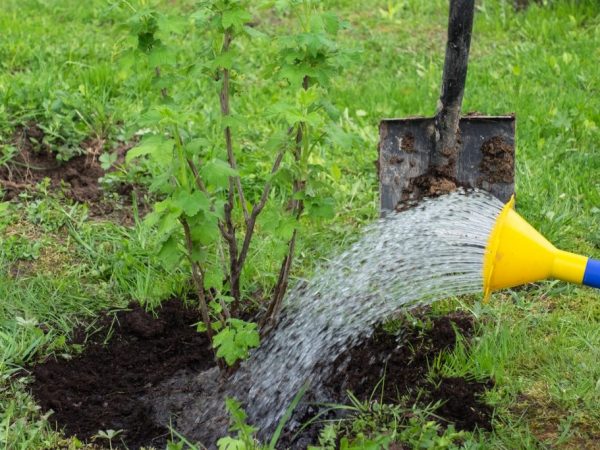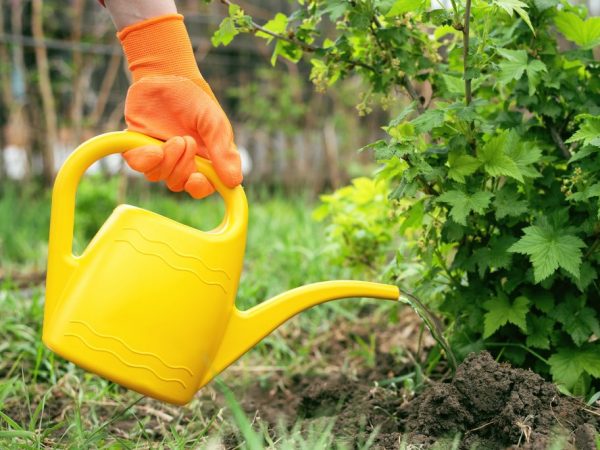Autumn feeding of currants - the main rules
Currant seedlings - our native Russian berry - are in great demand. Culture is almost a must in any vegetable garden. The beneficial properties of berries, and guaranteed fruiting, and unpretentiousness in care make it so. But in order to obtain the maximum and quality indicators of yield, you need to know the features of this plant and some of the nuances of growing. Feeding currants in the fall is one of the most important procedures. Let's see how to do it.

Autumn feeding of currants - the main rules
What are top dressing for?
After the end of fruiting, they begin to prepare the berry for winter and lay the foundations for the next year's harvest.
Preparation includes:
- pruning;
- thinning if necessary;
- treatment with insecticides and fungicides;
- water charging irrigation;
- mulching.
But the most important operation is the autumn feeding of currants.
During the year, each plant successively passes through a number of obligatory stages in its vegetative development:
- Awakening. Spring comes and activates the movement of juices in the roots and stems and the swelling of the buds.
- Bloom. In the second decade of May (in the middle lane), even before the leaves bloom, the currant begins to bloom. Flowering time - up to 7 days.
- Fruiting. Berries appear on the bushes in July - August, depending on the variety. Ripening of berries lasts 2-3 weeks.
During all these stages, the shrub consumes nutrient reserves.
In autumn, the time comes for the formation of resources for fruiting. It was during this period:
- buds of shoots and inflorescences are formed;
- forces are accumulated to withstand frost.
If you leave the bush without help at this time, then the next harvest may not wait.
The more nutrients the currant accumulates, the easier it will endure unfavorable winter conditions, and the larger and sweeter the berries will be next year.
Optimal timing
There are two types of fertilizers: organic and mineral. They differ in the nature of the impact. What they have in common are the nutrients supplied to the plants. The main ones are nitrogen, phosphorus and potassium.
Depending on the type, the timing of fertilization in the fall is distinguished:
- The first portion is brought in immediately after the end of fruiting (late August-early September).
- The next one is in October-November, a month before the constant frosts.
- The third - when freezing temperatures come (for the middle zone, this is the end of November-mid-December). This top dressing is applied even in the snow.
The main commandment of the gardener is that after mid-July I do not feed the bushes with nitrogen - for currants it must be strictly followed!
Nitrogen causes the development of young shoots, but they do not have time to ripen by winter and will die in frost. But a small percentage of this substance is still required by the plant for proper development. That is why organics are used in late autumn.
Dry fertilizers are applied in the fall when digging a trunk circle. To reduce the risk of root burns, you need to indent from the base of the bush a (dig a gutter around a circle up to 30 cm deep).
Organic fertilizers
The basis of organic fertilizers is plant residues. Of course, they contain both nitrogen and phosphorus in the form of organic molecules.
But the total number of these elements is small. So, most of all nitrogen in compost from leaves and green grass - 1.5%. Potassium in living organisms is present in the form of soluble salts and, if no special measures are taken, it is easily washed out with water.

Top dressing affects plant productivity
As a result, the main value of organic fertilizer is soil improver.
Organic matter introduced into the soil during planting improves its moisture and air permeability of the plant. And this contributes to the development of the mycelium of the fungus, which lives in symbiosis with the roots. In this union (mycorrhiza), the mycelium is a kind of continuation of the root system, supplying it with a significant part of the minerals dissolved in water. In return, the mycelium receives the substances necessary for life. A number of beneficial bacteria also live in symbiosis with the roots.
Animal products (manure, poultry / chicken droppings, feces) differ from purely vegetable products in the content of nitrogen compounds (urea):
- in cow manure - up to 2% nitrogen and up to 0.5% potassium and phosphorus;
- poultry droppings have 3% nitrogen.
These fertilizers cannot be used in autumn at freezing temperatures. But they will come in handy in the spring, especially since the nutrients contained in them should go into a chelated form. Only in this form can they be absorbed by the bush. Soil bacteria will convert organic matter of animal origin into chelates in 2-6 months.
Ash does not contain organic compounds, only mineral ones, with potassium and phosphorus in the composition.
| Application time | Fertilizer type | Rules and dosage |
| Until July | yeast | Yeast solution introduced into warm soil is a growth stimulant. Fungi decompose organic matter, releasing substances that are easily assimilated by plant roots. It is made from 1 kg of pressed yeast, 100 g of sugar, 2 glasses of wood ash. Let it brew for 2-4 hours. Dilute 1 liter of infusion in a bucket of water. Water no more than 2 times before fruiting. |
| September | Potato peelings (Only from absolutely healthy tubers!) | Introduce both in the form of an infusion and fresh or dried. There is no overdose, the main value of the purification is the high content of potassium and starch. For the effect under the bush, you need to bury up to 3-5 kg of fresh peelings or at least 1 kg of dried ones. The infusion is prepared in a 1: 2 ratio. Pour up to 5 liters under the bush. Spraying on a leaf is possible. |
| September-early October | Siderata | Close up shallowly into the soil. |
| November | Composts | It takes 2-4 months for bacteria to process. Bring in at the rate of 2-4 buckets per bush. Preliminarily loosen the soil slightly. |
| December | Manure | Use only rotted. Nitrogen from it has already disappeared, and for decomposition and transformation into a chelated form, the activity of soil bacteria is needed for 4-6 months. By the spring it will be ready for assimilation by plants. For 1 bush - a bucket of manure. It is laid out on the surface of the trunk circle and sprinkled with earth. Possibly shallow digging (no deeper than 0.5 shovel bayonet). |
| December | Bird droppings | 1 kg dry per bush. This fertilizer is scattered around the circumference at a distance of 30-40 cm from the trunk and slightly embedded in the soil with a hoe. Top mulch with peat or garden soil. When making a liquid infusion, 1 kg of manure is diluted with water in a ratio of 1:12. Pour 10 liters under the bush. |
Mineral fertilizers
Elements such as nitrogen, phosphorus and potassium play the most important role in plant life.

Nitrogen fertilizers cannot be used in autumn.
Nitrogen leads to the growth of green mass. Moreover, this can occur to the detriment of the formation of fruits (berries).
You can feed them only until the stage of flowering bushes. If applied in the fall, it will provoke the growth of green shoots. Young immature shoots are vulnerable to frost. They will not be able to survive the winter and will die.
Phosphorus increases the immunity of shrubs to diseases and pests, helps cells accumulate and retain moisture, which is very important in winter. Plants extract this component from the soil as needed. There cannot be too much of it.
Potassium stimulates all bioprocesses in the plant, strengthening it. That is why it is used during the fall preparation for winter.
| Application time | Fertilizer type | Fertilization rules and dosage |
| May June | Nitrogen (nitrate and urea) | Total dose: 20 g (one matchbox) per bush |
| May, June, September | Phosphorus (superphosphate) | Total dose: 40 g (two matchboxes) per bush. They are used only together with potash fertilizers! |
| May, June, September | Potassium (as potassium sulfate, potassium sulfate) | Total dose: up to 50 g per bush |
It is very convenient to use special "autumn" compositions for berries. They contain not only balanced basic elements (nitrogen, phosphorus, potassium), but also trace elements necessary for the plant.
Siderata
Green manure plants or green manures quickly build up green mass and develop a powerful root system. It is one of the most effective natural fertilizers.
Siderata perform several functions:
- Improves soil structure. Once mowed and embedded in the ground, their roots and stems become organic fertilizer.
- Suppresses the growth of weeds.
- They bind atmospheric nitrogen, converting it into nitrogen fertilizer. Alfalfa, peas and legumes have this ability.
- Prevents the spread of bacterial and fungal diseases (mustard, oats).
With regard to currants, the effect of them is lower than when using organic and mineral fertilizers. But on barren and depleted lands, the result from the use of green manure is not bad.
Green manure plants are used in different ways:
- dug up in the fall along with greens;
- the grass is mowed, crushed, mixed with wood ash and brought under the bush;
- cut off the top and use as mulch.
| Application time | Type of plant | Rules and dosage |
| In the beginning of May | Lupine | 20-30g / sq.m. Mowed 6-8 weeks after planting. They are embedded in the soil to a depth of 5-6 cm. |
| From spring to autumn, every 1.5-2 months | Mustard | 3-4 g / sq.m. The last sowing is in September. |
| After the snow melts | Phacelia | 1.5-2 g / m2 The green mass for embedding is cut off 45-50 days after sowing. |
All green manure must be mowed before seed formation so that they do not turn into weeds.
Suitable for autumn planting:
- fast-growing plants that are able to build up green mass before the onset of cold weather - peas, barley. They are sown in August;
- frost-resistant varieties: oats, vetch, lupine, phacelia. They manage to form a root system.
Fertilizing currants in the fall is part of the process of preparing for winter and laying the foundation for the future harvest. Yes, it will require expenditure of effort, money and time. But don't the fragrant, healthy and tasty berries deserve it?

